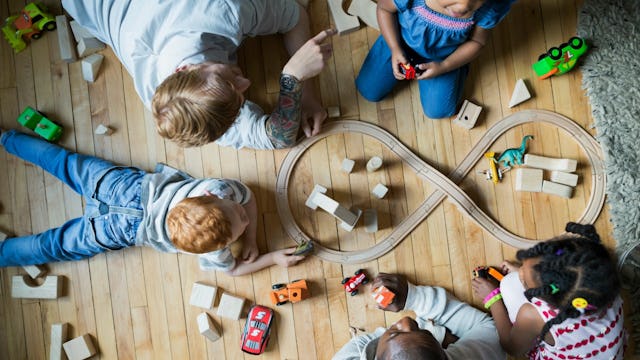Yes, My Biracial Son Sees Color. All Kids Do, And That's Not A Bad Thing.

“Look, it’s Uncle Gerald!”
I initially wondered how my younger brother, who lives two states away, managed to teleport into our living room before seeing that my 2-year-old son was pointing to the image on the TV screen.
It was NBA legend Kobe Bryant. In contrast to Bryant’s 6-foot-6 height, my brother might be 5-foot-9 on a good day. No one’s mistaking him for a basketball star.
Another day, my brother was two people — LeBron James and Seattle Seahawks quarterback Russell Wilson. A few weeks later, Uncle Gerald was a random college basketball player on one of those little-known NCAA basketball tournament teams guaranteed to get eliminated in the first round every year. (I watch a lot of sports.)
Although I knew Uncle Gerald had next-to-nothing in common with any of these men, I immediately understood what was happening. My son was starting to recognize skin color.
Uncle Gerald was “brown” like the African-American players that my son, B, saw on TV, and relatively young, albeit about a decade older than some of the college athletes. The comparisons were a bit amusing, but deep down, I was petrified.
No, I wasn’t scared of “race talk.” As a black mother, I know it’s inevitable, and black parents are more likely to initiate said talk earlier than other parents out of necessity, unfortunately. I also knew this was a normal stage of development, as kids see color differences in infancy and can verbally identify them as early as 2 or 3 years old.
But I didn’t know how to address it with a mixed-race child, one who might not see himself as either black or white, and one who might not yet have the understanding of being “both.”
First, I wondered if I had somehow dropped the ball, no pun intended, by not having him around more people of color. We live next door to an Indian family, and his daycare centers had a good mix of children from all racial, ethnic and national backgrounds, but most of the adults he saw on a regular basis were white.
Black adults, in particular, were few and far between. Although my family, all African-Americans of diverse ages and skin tones, spent as much time with B as they could, Uncle Gerald was the only young, black male adult with whom he had regular contact. I didn’t want him to start developing associations and stereotypes if, other than his uncle, he only saw young black men on TV throwing or bouncing a ball.
He was also seeing them as different from himself as a mixed-race child, even though he came from a brown-skinned mother. In my head, B was a person of color like me, one who would identify with the kids with brown skin and see the kids with “peach” or “white” skin as those who were different. I clearly remember asking around age 5 or 6 why people had white skin since everyone around me was brown.
But B’s experience has been a lot different, as is his appearance.
“So what color are you?” I asked out of curiosity one day.
He said he was white, like Daddy.
“You’re both brown and white,” I said. “You’re part like Mommy and part like Daddy.”
To be fair, he wasn’t much better distinguishing between white people either. On TV, “Daddy” was everyone from singer Michael McDonald to various politicians he saw on TV debating health care reform. He seemed to see skin color, but also distinguished age and body types.
He could associate specific white men with Dad and black women with Mom, making me happy that he was noting characteristics besides skin tone.
The more I listened, though, the more my fears were eased. Yes, my son noticed color differences, but he hadn’t picked up on societal messages that placed greater value on people with one skin tone versus another. He took special note of his friends with brown skin, or his friends from “Chinese,” but never said their skin or eyes were weird or ugly or bad. Even at his young age, children can start developing racial biases.
Maybe we were doing the right thing as a family in being intentional in participating in cultural events, looking for diversity among the children even at the daycare level, and making sure to purchase books and watch television programs that reflected the diversity of the United States. He saw it as normal for kids to have parents of different colors or for children and adults of all backgrounds to interact as friends. He could have “brown” family and “peach” family, and be comfortable with them all.
I’m not so naïve to believe that this level of racial harmony will persist forever.
Kids get older and inevitably start processing negative messages from others, but perhaps it’s a start if they can maintain authentic friendships at an early age that cross racial and ethnic lines.
Now, at age 5, B’s sense of identity and racial awareness has become a bit more evolved, although he still sees the world in Crayola colors. He no longer sees himself as white like Daddy, but more peach, and excitedly proclaimed in the bathtub one day that he was the same color as his younger brother (who didn’t exist at the time of the initial conversation).
Maybe he’s even light brown, but not as brown as Mommy, who’s brown like Uncle Gerald. (And he only compares Uncle Gerald to a select few athletes and musicians these days. Think P. Diddy/Puff Daddy/Diddy/Sean Combs.)
Baby B feels he’s a little of both, and he likes that. And so do I.
This article was originally published on